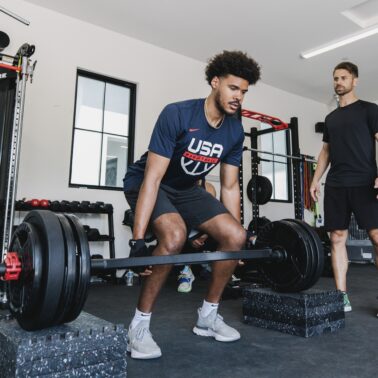“Whether it is early in rehab after surgery, or a low intensity day during a strength training program, the use of blood flow restriction training is a staple in my programming because of its wide array of performance enhancing effects.”
Adam Loiacono
What You Will learn
- How BFR improves muscle hypertrophy.
- The analgesic and pain modulating effects of BFR.
- How BFR produces a hormonal effect to enhance sports rehab or strength & conditioning programs.
In the realm of sports rehab, finding innovative and effective methods to expedite recovery and enhance performance is crucial. One such method that has gained significant attention is blood flow restriction (BFR) training. By utilizing specialized cuffs or wraps to partially restrict blood flow to working muscles, BFR training offers numerous benefits for athletes during the rehabilitation process.
Muscle Hypertrophy: The Intersection of Mechanical and Metabolic Stress
Muscle hypertrophy, or the growth and enlargement of muscle fibers, is a key objective in sports rehab. Traditionally, mechanical stress through heavy resistance training has been the go-to method for stimulating muscle growth. However, BFR training presents a unique approach by combining both mechanical and metabolic stress. The partial occlusion of blood flow during BFR exercises enhances the accumulation of metabolic byproducts, such as lactate, while also increasing mechanical tension on the muscles. This dual stimulus elicits a hypertrophic response similar to high-intensity resistance training, even with lighter loads. Research has shown that BFR training can yield substantial gains in muscle size, making it an effective tool for athletes in rehabilitation.
Pain Modulation: Reducing Discomfort, Enhancing Recovery with Blood Flow Restriction
Pain management is a critical aspect of sports rehab, and BFR training has demonstrated its ability to modulate pain levels effectively. BFR training triggers the release of endogenous opioids and stimulates the body’s pain-inhibiting mechanisms. The resulting analgesic effect provides athletes with the opportunity to train at lower intensities while still achieving significant benefits. Furthermore, BFR training can also reduce post-exercise muscle soreness, enabling athletes to recover more quickly and return to training sooner.
Tissue healing is a primary concern during the rehabilitation process, and BFR training has shown promise in accelerating this crucial aspect of recovery. By promoting the release of growth factors such as vascular endothelial growth factor (VEGF) and insulin-like growth factor-1 (IGF-1), BFR training enhances angiogenesis and collagen synthesis. These processes facilitate the regeneration of damaged tissues, including muscles, tendons, and ligaments. Additionally, BFR training may also improve the delivery of nutrients and removal of waste products at the cellular level, further supporting tissue healing and recovery.
Hormonal Response: Unlocking the Body’s Growth Potential
BFR training elicits a unique hormonal response that contributes to its efficacy in sports rehab. During BFR exercises, the restriction of blood flow leads to the accumulation of metabolites and a reduction in oxygen availability. This metabolic stress stimulates the release of anabolic hormones, including growth hormone (GH) and insulin-like growth factor-1 (IGF-1). These hormones play vital roles in muscle hypertrophy, tissue repair, and overall recovery. Moreover, BFR training has also been shown to increase circulating levels of testosterone, further promoting an anabolic environment in the body. Harnessing this hormonal response through BFR training can optimize sports rehab outcomes.
General Guidelines for Performing Blood Flow Restriction Training during Rehab
When incorporating BFR training into sports rehab protocols, it is essential to follow appropriate guidelines to ensure safety and maximize benefits. Here are some general recommendations:
- Seek Professional Guidance: Consult with a qualified sports rehab professional who has experience in implementing BFR training. They can provide personalized guidance based on your specific needs and goals.
- Choose the Right Equipment: Utilize high-quality BFR cuffs or wraps that allow for safe and controlled pressure regulation. Ensure they are properly fitted to minimize discomfort and potential risks.
- Gradual Progression: Start with lower pressure levels and lighter loads to allow the body to adapt gradually. Slowly increase pressure and resistance over time as tolerance and strength improve.
- Exercise Selection: Incorporate a variety of exercises that target the specific muscles and movements relevant to your sports rehab goals. Focus on exercises that can be performed safely with BFR training.
- Duration and Frequency: Begin with shorter BFR training sessions (5-10 minutes) and gradually increase duration as tolerated. Aim for 2-4 sessions per week, allowing ample time for recovery between sessions.
- Monitoring and Adjustments: Regularly assess your progress, monitor any discomfort or adverse effects, and make adjustments to your BFR training protocol as needed. Communicate openly with your rehab professional.
Conclusion
Blood flow restriction training has emerged as a promising tool in the realm of sports rehab, offering a range of benefits including muscle hypertrophy, pain modulation, tissue healing, and hormonal response. By integrating BFR training into rehabilitation protocols, athletes can accelerate their recovery process and enhance performance.
However, it is crucial to approach BFR training with caution, adhering to appropriate guidelines and seeking professional guidance to ensure its safe and effective implementation. With its unique ability to stimulate muscle growth, alleviate pain, and promote tissue healing, BFR training has the potential to enhance sports rehab and unlock new possibilities for athletes on their road to recovery



